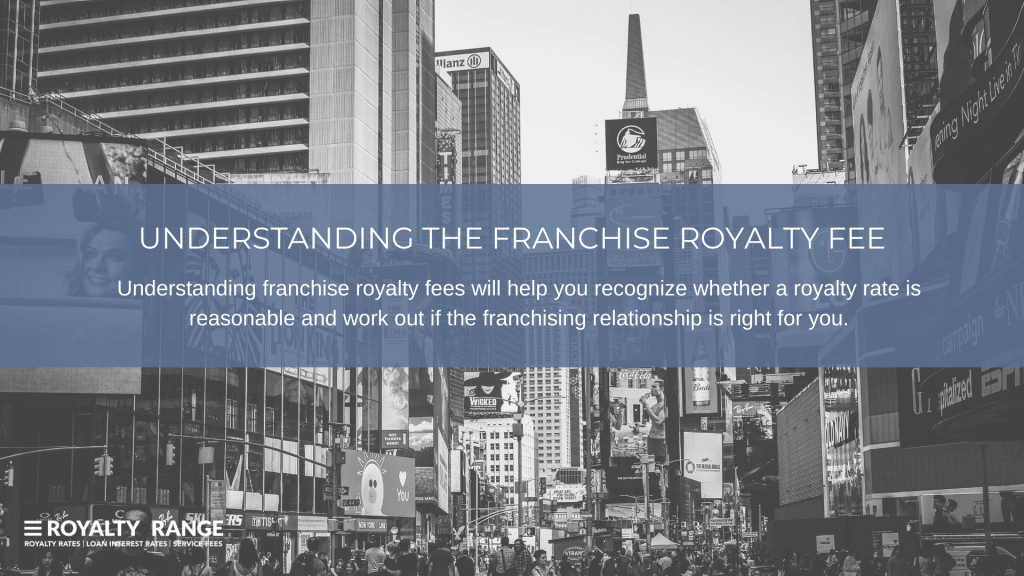Understanding the franchise royalty fee

Kris (Kestutis) Rudzika |
July 15, 2020

If you’re a prospective franchisee or a business owner who’s franchising their business, you need to know how to determine a fair franchise royalty fee. Understanding franchise royalty fees will help you recognize whether a royalty rate is reasonable and work out if the franchising relationship is right for you. In this article, we’ll explain what a franchise royalty fee is, why royalties are important in franchising agreements and the different types of franchise fees you can use. We’ll also discuss how to find average franchise royalty fees and get an expert franchise royalty fees comparison.

License fee vs royalty
First, let’s clear up the ‘license fee vs royalty’ question. Are license fees and royalties the same? The short answer is: yes, royalties are a form of license fee. So, if the term ‘license fee’ is used, it might be referring to royalty rates. However, royalty payments are not the only type of license fee available. There are also fixed license fees, upfront license fees and milestone license fees.
Now, here are the 3 steps to setting royalties and license fees for the use of intellectual property:
1. Decide what type of royalties and license fees to set
The first step in determining fair royalties and license fees is to know all the types of payment that are going to be required as part of the licensing deal. Royalty payments are only one type of license fee – licensors can also request upfront payments, milestone payments and other fees.
It’s important to know what types of payment are going to be set in the licensing agreement, as they can affect the royalty rate. For example, if a licensor charges a substantial upfront payment for the use of their intellectual property, they may charge a slightly lower royalty rate to balance things out. This is something to keep in mind if you look at comparable license agreements to help you work out market rates, as the royalties may be affected by other license fees being charged.
The most common scenario is that a licensor sets an initial lump-sum payment, followed by regular royalties. Royalty rates are usually agreed as a percentage of net or gross sales, but they can also be fixed fees paid on a regular basis. Royalty percentages can either be fixed or variable.
2. Choose a calculation method
The next step is to work out the value of the intellectual property in question, and calculate an appropriate license rate. There are three main approaches you can choose from:
- The market approach: To use this approach, you need to find recent market data for comparable license agreements. The method works by finding out what royalties and license fees other companies charged in comparable license deals, and then using this reliable market data as a starting point to base your royalty rates and license fees on.
- The income approach: Income approaches base the value of the intellectual property on the income that it is expected to generate in the future. The most common income-based method is the discounted cash flow (DCF) method.
- The cost approach: To use this approach, you need to work out the cost of buying or developing similar intellectual property assets. The idea is that the intellectual property shouldn’t be valued at more than what a similar asset would cost to make or buy. The cost approach is a good option for valuing complex patents or intellectual property that hasn’t been proven in the market yet.
3. Check your results against recent market data
Whichever calculation method you use to determine royalties and license fees, you should always check your calculated rates against market data. Ideally, you’ll use a combination of all three approaches to make sure your calculation is as accurate as possible. That way, if you come to different conclusions with each approach, you’ll know that you need to tweak something in your calculation. By checking your royalties and license fees against market data, you’ll be able to check that they’re in line with market rates. This enables you to go into license royalty negotiations with a strong understanding of the market rate, which will help you gain the royalty rate you want.
Find out what royalties other companies are setting
You can find comparable royalties and license fees for the use of intellectual property by searching the RoyaltyRange database. All our data is manually gathered from real license agreements between independent parties, and is analyzed against more than 50 comparability factors. This means that you’ll only see potentially comparable agreements that are relevant to your search.
Use the One Search form to the right of this page to start your search. One Search is a one-off database search service – no subscription required.
Request One Search
We will perform the search and deliver the initial results within hours, at no cost.




